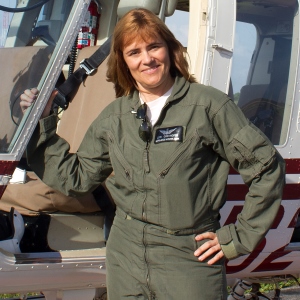Wildlife Biologist
Everglades National Park
Responsibilities: Oberhofer oversees wildlife monitoring in the park, typically “indicator species” such as wading birds and alligators. She also monitors endangered species, including the Florida panther and the Cape Sable seaside sparrow. “We need good data to help manage the park. Long ago, the Everglades were diked and dammed. Even today, lots of water in the park is managed, even though it’s a huge wilderness area. The big goal is getting it back to historic levels and flow ways. I keep an eye on wildlife to make sure restoration projects don’t affect them in a negative way.”
Years in current position: 1
Years with the Park Service: 16
 Career path:
Career path: Oberhofer earned her bachelor’s degree in animal husbandry from Southern Illinois University. While in graduate school at the University of Montana, Oberhofer volunteered for a study looking at wolf impacts on elk and deer in Glacier National Park. Subsequent seasonal jobs with NPS included the study of spoonbills in Florida. She also worked on projects in Wyoming, Guam, and Hawaii for the Department of the Interior and various universities.
What makes my park special: “The Everglades were set aside to preserve its diversity of plants and wildlife. Some, like the American crocodile, are at the northernmost point in their range. There are about 360 species of birds in the park. If you’re into birdwatching or [a] wildlife photographer, it’s a primo place.”
Typical day: “On field days, I fly a lot in airplanes and helicopters doing aerial surveys over places like Shark River Slough and Taylor Slough, which are rivers of grass. On office days, I work on data, budgets, personnel, scheduling, and collaboration with partners.”
Biggest challenge: Everglades National Park is 1.5 million acres. “The logistics are a challenge. There’s no way we can do it on our own. We work with Audubon of Florida, several universities, and the state of Florida. It’s challenging to get out there, whether in a helicopter, an airboat, or a canoe or kayak. The other challenges are government-wide: doing a lot more with diminished budgets. A lot of what I do is for the love of the park. I volunteer extra hours, often working on weekends, because I like what I do.”
Best part of the job: “Standing in water in the remote parts of the Everglades. The water is so clear I can look down and see little fish around my feet and a little flow going south . . . . The work we do really does help us manage the park better so we can protect and preserve it. I’m a small piece of it, but what we all do is important for future generations to see it and protect it.”
Advice for visitors: “The best way to experience the Everglades is to get out and do it. Check out the ranger projects, bike, hike, paddle, fish, tent, or RV camp. Come during the non-summer months when it’s cooler and less buggy. January through May is peak wading bird nesting time. It’s also the dry season, so the water is in pools, which collect more fish and gators. Hike the Anhinga Trail along Taylor Slough, where you’re guaranteed to see turtles, fish, gators, and other wildlife.”
Favorite national park: “Glacier National Park. I like the mountains, and it feels like home. That park to me is everything — scenic beauty, wildlife — and it was the first park I worked in.”
Learn more about our national parks! View historic photos, listen to audio on how the film, "Our National Parks: America's Best Idea," was created, and learn about activities and events the park system offers.